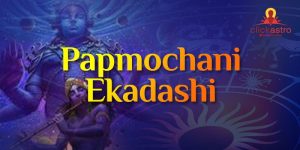Contents[hide]
What is Ekadashi Vrat?
Ekadashi is a combination of two words Eka and Dashi which stands for ‘Eleven’ in Sanskrit. The Ekadashi fast is one of the most significant fasts as per the Hindu calendar and is observed by Hindus and Jains. Ekadashi is also known as Tholi Ekadashi in some parts of India. The festival is dedicated to Lord Vishnu and devotees observe a partial/complete or stricter Nirjala (without water) fast on this day. The Ekadashi fast spans three days starting from Dashami (tenth day) and ending on Dwadashi (twelfth day). The devotees consume a single meal at noon on Dashami to avoid the presence of food that remains on the day of fasting (Ekadashi). The fast is broken on the Dwadashi (twelfth day) after completing the puja rituals. It is also believed that the water in our bodies is influenced by the lunar phases and can cause imbalances in the body. Abstaining from food and cleansing oneself during the Ekadashi time is believed to be beneficial to the body as it protects the body from any negative effects of the lunar phases on the body. Get FREE personalized horoscope predictionsEkadashi Days and Presiding deity
According to the Vedic calendar, there are 24 Ekadashi days in a year with two extra Ekadashi observed during the leap year making it a total of 26 Ekadashi days. Every Ekadashi day worships the presiding deity of Lord Vishnu known in various names and forms and also holds specific significance attached to it. The recommended puja rituals and practices may also vary according to each Ekadashi day which is assumed to benefit the devotees undertaking the vrat. People may observe a strict or partial fast and should refrain from consuming rice, grains, and beans. Those undertaking a partial fast may consume milk and fruits.| Vedic lunar month (Gregorian calendar) | Presiding deity | Krishna Paksha Ekadashi | Shukla Paksha Ekadashi |
| Chaitra (March–April) | Ram Vishnu | PapamochiniEkadashi | Kamada Ekadashi |
| Vaisakha (April-May) | Madhusudana (Vishnu) | Varuthini Ekadashi | Mohini Ekadashi |
| Jyestha (May-June) | Trivikrama (Vishnu) | Apara Ekadashi | Nirjala Ekadashi |
| Ashaada (June-July) | Vaamana | Yogini Ekadashi | Devashayani Ekadashi |
| Shravana (July-August) | Sridhar | Kamika Ekadashi | Shravana Putrada Ekadashi |
| Bhadrapada (August-September) | Hrishikesh (Vishnu) | Annada Ekadashi | Paarshwa Ekadashi |
| Ashwin (September – October) | Padmanabha | Indira Ekadashi | PashankushaEkadashi |
| Karthik (October – November) | Damodara | Rama Ekadashi | Prabodhini Ekadashi |
| Marghashirsha/Agrahayana (November-December) | Keshava | Utpanna Ekadashi | Mokshada Ekadashi/Vaikunta Ekadashi |
| Pausha (December –January) | Naarayana(Vishnu/Krishna) | Saphala Ekadashi | Pausha Putrada Ekadashi/Vaikunta Ekadashi |
| Magha (January – February) | Madhava | Shattila Ekadashi | Bhaimi Ekadashi/Jaya Ekadashi |
| Phalguna (February-March) | Govinda (Krishna) | Vijaya Ekadashi | Amalaki Ekadashi |
| Adhika month (once in 2-3 years) | Purushottama | Padmini Visuddha Ekadashi | ParamaaShuddha Ekadashi |
Significance of Ashadi and Vaikuntha Ekadashi
Of the 24 Ekadashi fasts observed in a year, Ashadi Ekadashi and Vaikuntha Ekadashi are the most significant Ekadashi days. The Ashadi Ekadashi or Maha Ekadashi is observed in the month of Ashada during the Shukla Paksha (waxing phase of the moon). It is believed that Lord Vishnu goes into a deep meditative state (Yoga Nidra) at the passing of the Ashadi Ekadashi and wakes up after four months on Prabodhini Ekadashi. Vaikuntha Ekadashi is observed during the Shukla Paksha in the month of Margashirsha. Vishnu devotees believe that ‘Vaikuntha Dwaram’ also known as ‘the gate to the Lord’s Inner Sanctum’ is opened on this day. This festival is celebrated with great fervor by arranging special prayers and yajnas at Vishnu temples around the world. Know About Your Life, Character & Destiny. Get FREE Kundli now!Nirjala Ekadashi Vrat Katha
Each of the 26 Ekadashi days has a ‘Vrat Katha’ associated with it which describes the reason why the fast is undertaken and what are the benefits of undertaking the specific vrats. The vrat katha of Nirjala Ekadashi is one among them. Legend has it that Bheema, the second of the Pandava brothers was fond of eating and failed to control his hunger. His hunger pangs did not allow him to perform the Ekadashi fasting with utmost sincerity as his brothers and Draupadi. This put him in a fix and he was saddened by the thought that by not observing Ekadashi Vrat, he was disrespecting Lord Vishnu. To seek a solution to his dilemma Bheema approached Maharishi Vyasa for help who advised him to undertake the Nirjala Ekadashi Vrat once a year. Maharishi Vyasa also explained to Bheema how performing one Nirjala Vrat was equivalent to undertaking twenty-four Ekadashis of the year. This is also one of the prime reasons why Nirjala Ekadashi also came to be known as Bhimsen Ekadashi or Pandava Ekadashi. Similarly, every Ekadashi Vrat Katha mentions the significance of undertaking the vrat, and devotees recite these vrat stories while undertaking the fast.How to do Ekadashi Vrat?
The Ekadashi vrat must be taken with utmost pious and pure mind. By following the rituals appropriately, the devotees are absolved of their sins and shall attain Vaikunthapura. The rituals are as below: On Ekadashi day, one must wake up early before sunrise, take a bath and wear clean clothes. Clean the puja area and decorate the puja area with flowers and decorations. Place the idols and decorate them with sandalwood paste, flowers, and light an incense stick. Take a vow (Sankalp) in the puja room or the temple and light an oil lamp. Perform the puja by reciting the Vishnu mantra “On NamoBhagavateVasudevaya” and start meditation. The devotees must abstain from consuming food and water the entire day. A Jagran is also held where the devotees stay awake the entire night reciting the mantras and hymns in praise of Lord Vishnu and also recite the associated ‘Vrat Katha’ for each Ekadashi. The fast is concluded the next day by taking a bath early before sunrise and performing the puja. After worshipping the Lord, the devotees offer donations to the Brahmanas, poor and needy in cash and/or kind. After performing the final aarti, the puja is concluded and the devotee partakes food and breaks their fast.Ekadashi Vrat Vidhi and Ekadashi Fasting rituals
The Ekadashi vrat requires following certain food restrictions. The longstanding rule has been that individuals must avoid peas, grains, and any type of cereals. Milk products, fruits, and root vegetables are on the list of permissible edibles. People undertaking the Ekadashi Vrat must not consume any sort of meat, liquor, or tobacco products during the fasting period.Dos and Don’ts of Ekadashi fast
- Avoid consuming rice, peas, grains, or any type of cereals.
- You can have limited portions of milk, fruits, dry fruits, roots, and vegetables.
- Do not pluck Tulsi leaves during Ekadashi Vrat as it is said that Lord Vishnu is offered Tulsi on Ekadashi and Dwadashi. It is forbidden in Hindu scriptures.
- Do not use powdered asafoetida (hing) in any preparation, as it generally contains grains.
- On Ekadashi Vrat non-veg (meat, fish, eggs), mushrooms, liquor, intoxicants (cigarettes, tobacco), and other tamasic food are strictly prohibited.










I have lost my job in June, 2019. I m still jobless. When I will get new job ?
My Moon sign is – VIRGO.
Hi,
My daughter name is Yaazhisai
DOB : 26-09-2017
Time : 9.53 am
Please suggest me auspicious day for ear piercing in the month of Thai 2020.
Hi,
Dates for ear piercing
16 January Thursday Magha K. Shashti Hasta From 07:15 to 09:42
17 January Friday Magha K. Saptami Chitra From 07:15 to 07:28
27 January Monday Magha S. Tritiya Shatabhisha From 07:12 to 19:12
30 January Thursday Magha S. Panchami Uttara Bhadrapada From 15:12 to 19:00
31 January Friday Magha S. Shashti Revati From 07:10 to 18:10
7 February Friday Magha S. Trayodashi Punarvasu From 07:06 to 18:24
13 February Wednesday Phalgun K. Panchami Hasta From 07:02 to 20:02
14 February Friday Phalgun K. Shashti Swati From 07:01 to 18:21
17 February Monday Phalgun K. Navami Jyeshtha From 14:36 to 20:06
21 February Friday Phalgun K. Trayodashi Uttara Ashadha From 09:13 to 17:21
28 February Friday Phalgun S. Panchami Ashwini From 06:48 to 19:23
my baby was born in 7/8/2019.can you find a date for annaprashan. between 21st to 30th December 2019 .please help.
Hi,
Thre is no annaprashan muhurat between 21st to 30th December 2019
For a baby girl, Annaprashan is usually celebrated in the odd months which is the 5th or 7th month.
Annaprashan Dates In 2020 January
Date Day Month & Tithi Nakshatra Annaprashan Muhurat Duration
2 January 2020 Thursday Pausha S. Saptami Purva Bhadrapada From 07:14 to 12:44
8 January 2020 Wednesday Pausha S. Trayodashi Rohini From 07:15 to 13:56
27 January 2020 Monday Magha S. Tritiya Shatabhisha From 07:12 to 14:37
29 January 2020 Wednesday Magha S. Chaturthi Purva Bhadrapada From 12:13 to 14:29
30 January 2020 Thursday Magha S. Panchami Uttara Bhadrapada From 07:11 to 13:20
please send a jupiter transit report emails i want to buy for with rs799
Hi,
Clickastro’s personalized Jupiter Transit Report 2019 will give you exact information, predictions and guidance about this transit. It studies the transit in comparison to your birth chart and gives you predictions and remedies for the period. Get Now
https://www.clickastro.com/jupiter-transit-predictions?cmpCode=BLOG
Thanks for sharing valuable information.
Hii I want to ask when I got my true love & when I got marry or is going to love marriage or arrange marriage of mine..
I would like to start Ekadashi vrat..pls suggest suitable date to start